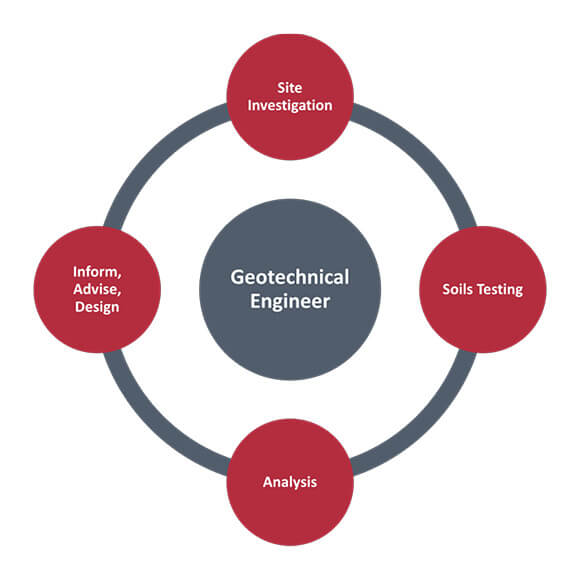Examine This Report on Geotheta
Examine This Report on Geotheta
Blog Article
Geotheta - The Facts
Table of ContentsThe smart Trick of Geotheta That Nobody is Talking AboutGetting My Geotheta To WorkGeotheta - QuestionsGeotheta Fundamentals ExplainedThe 9-Second Trick For Geotheta

They perform site investigations, gather examples, execute lab examinations, and examine data to examine the viability of the ground for building and construction projects - Consulting Engineers. Based on their findings, geotechnical engineers offer suggestions for structure design, slope stability, retaining frameworks, and reduction of geotechnical hazards. They work together with various other experts, such as architects, structural engineers, and building teams, to make sure that geotechnical factors to consider are incorporated right into the general job style and implementation
By analyzing the actions and residential properties of dirt and rock, they can recognize possible geotechnical risks such as landslides, dirt negotiation, or slope instability. Their competence assists avoid failures or crashes that can jeopardize lives and residential or commercial property. Below are some detailed tasks and obligations of a geotechnical engineer: Site Investigation: Geotechnical engineers conduct website examinations to gather data on subsurface problems.
They interpret the data to comprehend the residential or commercial properties and behavior of the soil and rock, including their strength, permeability, compaction characteristics, and groundwater problems. Geotechnical Analysis and Layout: Geotechnical designers examine the information collected throughout website examinations to examine the security and suitability of the site for building projects. They perform geotechnical estimations and modeling to evaluate aspects such as birthing capacity, settlement, incline security, lateral earth pressures, and groundwater circulation.
The Main Principles Of Geotheta
Structure Style: Geotechnical engineers play a critical function in developing structures that can safely support the desired framework. They analyze the dirt conditions and tons requirements to determine the ideal foundation type, such as superficial structures (e.g., grounds), deep structures (e.g (https://hub.docker.com/u/geotheta)., stacks), or specialized methods like soil renovation. They take into consideration variables such as settlement restrictions, birthing capacity, and soil-structure communication to establish ideal foundation designs
They assess construction strategies, display site activities, and perform field assessments to validate that the design suggestions are complied with. If unpredicted geotechnical concerns arise, they evaluate the scenario and give recommendations for remediation or changes to the design. Danger Evaluation and Reduction: Geotechnical designers analyze geotechnical threats and risks related to the job site, such as landslides, liquefaction, or soil disintegration.

Collaboration and Communication: Geotechnical designers work closely with other specialists associated with a project, such as designers, structural designers, and construction groups. Effective interaction and collaboration are vital to incorporate geotechnical considerations into the total job layout and building process. Geotechnical engineers give technological knowledge, response queries, and guarantee that geotechnical demands are fulfilled.
The Facts About Geotheta Uncovered
Right here are some types of geotechnical engineers: Structure Engineer: Foundation engineers concentrate on making and examining structures for structures. They analyze the dirt conditions, load needs, and site qualities to identify the most suitable foundation kind and design, such as superficial foundations, deep foundations, or specialized techniques like heap structures.
They assess the elements affecting slope stability, such as dirt residential properties, groundwater problems, and slope geometry, and create approaches to stop slope failures and mitigate threats. Quake Engineer: Quake designers specialize in evaluating and creating structures to withstand seismic forces. They analyze the seismic threat of a website, review dirt liquefaction possibility, and develop seismic style requirements to ensure the safety and durability of structures during earthquakes.
They do field screening, collect examples, and examine the gathered data to define the soil buildings, geologic developments, and groundwater problems at a website. Geotechnical Instrumentation Designer: Geotechnical instrumentation engineers focus on surveillance and measuring the behavior of soil, rock, and structures. They set up and preserve instrumentation systems that check variables such as soil settlement, groundwater degrees, incline movements, and architectural displacements to evaluate performance and provide early warnings of potential concerns.
Geotheta for Dummies
They carry out tests such as triaxial examinations, combination examinations, direct shear examinations, and leaks in the structure examinations to gather data for geotechnical analysis and design. Geosynthetics Designer: Geosynthetics designers concentrate on the design and application of geosynthetic materials, such as geotextiles, geogrids, and geomembranes. They use these products to enhance soil stability, enhance slopes, provide drainage remedies, and control erosion.
They have a tendency to be investigatory people, which means they're intellectual, introspective, and analytical. They wonder, systematic, sensible, logical, and logical. Some of them are additionally social, indicating they're kind, charitable, participating, patient, caring, helpful, empathetic, tactful, and pleasant. Does this audio like you? Take our here are the findings complimentary career test to discover if geotechnical engineer is just one of your top job matches.
In the workplace setting, geotechnical engineers use specialized software application devices to execute calculations, develop designs, and evaluate information. They prepare reports, testimonial job requirements, connect with clients and employee, and coordinate task activities. The workplace setting supplies a favorable environment for study, evaluation, and partnership with various other experts involved in the project.
Geotheta Things To Know Before You Buy
They frequently check out project websites to carry out site examinations, analyze geotechnical conditions, and gather information for evaluation. These brows through entail taking a trip to various places, often in remote or difficult surfaces. Geotechnical designers may execute soil sampling, conduct tests, and screen building activities to make certain that the geotechnical aspects of the project are being carried out correctly.
Geotechnical designers additionally work in specialized geotechnical research laboratories. Geotechnical research laboratory designers work extensively in these settings, handling testing tools, running instruments, and videotaping information.
Report this page